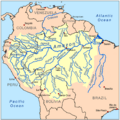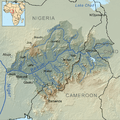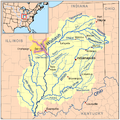Tributary facts for kids
A tributary is like a smaller river or stream that flows into a bigger river. Think of it as a helper river! When one river joins another, the first river is called a tributary of the second one. So, a tributary is simply any body of water that flows into a larger body of water.
The opposite of a tributary is a distributary. A distributary is a river that splits off from the main river. You often see distributaries in places like a river delta, where a river spreads out into many smaller channels before reaching the ocean.
Contents
What is a Tributary?
A tributary is a stream or river that flows into a larger stream or river. It does not flow directly into an ocean or a sea. Tributaries are sometimes called "affluents."
How Tributaries Work
Imagine a big river, like the Amazon River. Many smaller rivers and streams flow into the Amazon, adding their water to it. These smaller rivers are all tributaries of the Amazon.
When you look at a map of a river system, you'll see the main river and lots of lines branching off and joining it. These branching lines are the tributaries. They collect water from a wide area and bring it to the main river.
Why Tributaries are Important
Tributaries are very important for several reasons:
- Water Supply: They bring water from different areas to the main river. This helps keep the main river full and flowing.
- Ecosystems: Tributaries create different habitats for fish, plants, and other wildlife. They are a key part of a river's ecosystem.
- Shaping the Land: Over time, tributaries help to carve out valleys and shape the landscape.
- Human Use: People often use tributaries for things like fishing, boating, and even as a source of drinking water.
River Basins and Tributaries
A river basin, also known as a drainage basin or watershed, is the entire area of land where all the water drains into a single main river and its tributaries.
How Basins are Formed
Think of a giant bowl. All the rain and snow that falls inside that bowl will eventually flow to the lowest point. A river basin works similarly. All the water that falls within its boundaries flows into the tributaries, which then carry it to the main river.
For example, the Amazon River has a massive basin. This basin includes all the land where rain falls and eventually makes its way into the Amazon or one of its many tributaries.
Types of Tributaries
Tributaries can be described by which side of the main river they join.
- Right Tributary: This is a tributary that joins the main river from the right side. You figure this out by looking downstream (in the direction the river flows).
- Left Tributary: This is a tributary that joins the main river from the left side, again, when looking downstream.
Some tributaries are seasonal, meaning they only flow during certain times of the year, like after heavy rains or during snowmelt. Others flow all year round.
Images for kids
-
Looking downstream, the Shenandoah River (bottom right) meets the Potomac River which flows from bottom left to top right, so the Shenandoah is a right tributary of the Potomac, not a left tributary.
-
The basin of the Amazon River is a system made up of many tributary streams. The streams shown on the map besides the Amazon are tributaries of the Amazon. The Amazon is not a tributary of any other rivers because it ends in the Atlantic Ocean.
-
The Benue River is fed by multiple tributaries originating in the Adamawa Plateau; many of the highest tributaries are seasonal streams. The Benue is itself a major tributary of the Niger.
-
Huai River (which itself is a tributary of the Yangtze River) and tributaries.
-
Jialing River (which itself is a tributary of the Yangtze River) and tributaries.
-
The Mekong is a trans-boundary river, originating in the Tibetan Plateau. Its upper tributary river systems (e.g. the Salween River) are restricted to narrow gorges, but the tributaries that feed its lower reaches (e.g. the Mun River) cover larger areas.
-
The water basin of the Wabash River; the other rivers (not including the Ohio River) are tributaries of the Wabash River. The Vermillion River (and its forks) is a highlighted example of a tributary of the Wabash River. The Wabash River is also a tributary of the Ohio River, which in turn is a tributary of the Mississippi river.
See also
 In Spanish: Afluente para niños
In Spanish: Afluente para niños









